Here are the different parts of my project!
Cards:
Map of various filming locations from movie adaptations:
Pie Chart:
Bar Graph:
Network Visualization:
Here are the different parts of my project!
Cards:
Map of various filming locations from movie adaptations:
Pie Chart:
Bar Graph:
Network Visualization:
In looking for Book Traces of previous readers of 19th century books in the library, I came up empty handed. Although I was unsuccessful, I did learn a lot through this assignment and have some guesses as to why I didn’t find any Book Traces in the library.
At first, I had high hopes for this assignment. I was really looking forward to finding old traces of writing in 1800’s books, it didn’t occur to me that people marked up their textbooks years ago too! Initially, I thought finding Book Traces would be an easy task, but as it turned out, it was far from it. One thing I did learn was that our own library was home to over 500,000 books! I imagined I would have no problem finding what I needed, until I learned that only 2,000 of these books were from the 19th century.
There were several reasons why I believe I didn’t find any Book Traces in our library. One of the biggest being the supply- with less than 1% of the books in the Sojourner Truth Library being from the 19th century, it seemed like finding a needle in a haystack. It was also discerning to find out that the library largely eliminates any book donations they get with writing in them. For the sake of Book Traces, I think it would be nice if in the future, our Library preserved and maintained Book Traces (so long as they didn’t infringe on the actual text of the book) and made an effort to have more 19th century books with Book Traces.
Another issue I had was finding appropriate 19th century books that would have writing in them. I searched through dozens of books, and I kept running into old Encyclopedia/ Textbooks, instead of any with literature or stories in them. Some titles included “Religious Science”, “Complete Works of Shakespeare” and so forth. To my surprise, not many old textbooks were marked in nearly as much as newer editions are today. My theory is that these old books were kept as sets, and remained untouched on shelves for much of their lives. I did try searching for keywords such as “journal” and “diary” to find some better material with a higher probability for booknotes, but still did not have any luck.
Although I was not successful this time around, I hope to have future encounters with Book Traces, and look forward to when I can find some Book Traces of my own!
200 topics, 7500 iterations, 10 topic words
Physical Description- man, hair, cut, middle, appearance, short, clean, faced, eagerly, shaven
Crime Scene- dead, body, found, knife, blood, cut, wound, death, heavy, lag
Travel- train, station, carriage, journey, roof, bridge, started, body, leave, ticket
Writing- paper, note, wrote, written, book, handed, writing, sheet, slip, write
Smoking- room, pipe, sat, fire, cigar, tobacco, chair, smoke, lit, writing
Marriage- woman, love, wife, husband, loved, knew, life, heart, married, women
Crime Solving- case, interest, points, remarkable, facts, singular, problem, fact, experience, solution
Time- night, hour, late, quarter, clock, work, twelve, eleven, time, ten
Business- hundred, money, pounds, business, thousand, company, price, sum, terms, pay
Light- light, lamp, darkness, dark, match, lantern, gas, lit, heavily, burning
One of my favorite short stories is The Yellow Wallpaper by Charlotte Perkins Gilman. It was first published in 1892. In the haunting narrative, Gilman critiques common medical practices for women affected by things such as “hysteria” and “neurasthenia” after childbirth. My sources for the information are scattered throughout this post as links.
The common treatment of the time was the “rest cure.” It left the woman tethered to a bed with no means to express herself, writing or otherwise.. This supposedly promoted healthy blood flow, and removal from too much stimulation. It’s now widely recognized as a load of junk, a part of a largely misogynistic tradition that controlled women’s bodies. Nevertheless, Doctor Silas Weir Mitchell and his bed rest cure has a solidified place in literature, women’s health, and history.
Based on the story, and my slight interest in the subject matter, I chose to look at the terms “apothecary,” “hysteria,” and “neurasthenia” on the Oxford English Dictionary.

Charles Dickens, Edgar Allan Poe and Herman Melville are three Victorian authors that particularly interest me. The choice of settings to search for them on Ngram Viewer was simple, then. My single concern was using capital letters, as I was searching for people’s names and limit the period of time from 1800 to 1900.
According to the resulting graphic, the three writers are not mentioned until 1833, as they were really young and starting their careers. Poe was born in 1809, Dickens was born in 1812 and Melville in 1819. Dickens started submitting his sketches of the life in London to magazines in 1833. It is exactly the year that the graphic shows that he started to be more mentioned, a movement that continued increasing till 1871. A suggestion for the relative decrease in the graph at this time in his death on June 8, 1870. He left an unfinished novel, The Mystery of Edwin Drood. It has already started to be published in a serial form since April 1870. Analyzing the graphic, we can consider that Charles Dickens died on the top of his career. Since 1877, we can verify a new growth in his “popularity”. In this year, a book called The works of Charles Dickens was published and may be the reason to this new growth.
In the case of Herman Melville, we can see that he has been more mentioned during the 1840s. It may be related to his trips over the sea, that gave him the material for four books in addition to Moby Dick. However, this novel that would be his great success, was not received well at the time because of its unusual combination of “whaling lore” and metaphysical themes. This may be the reason of his relatively low popularity over the 19th century, compared to Charles Dickens.
Edgar Allan Poe had a brief life – he died on October 7, 1849, before he has started to be more mentioned, according to Ngram Viewer. The graphic shows a special increase in Poe’s mentions over the 1870s. The reason may be the biographies and other works about him that have been published since 1870.
After failing to find any marginalia in the first few books I looked through, which were based upon my original database query, I happened upon The Plays of Richard Brinsley Sheridan. The book was written by Richard Brinsley Sheridan, who was a playwright and politician, among other things. He wrote them in the late 18th century, so I hoped for some insight from those students who had come before me, likely while studying English literature.
The book itself seems to have been repaired, and the title and authors’ name on the spine of the book was handwritten. Inside, It was heavily marked, albeit in pencil, which unfortunately indicated that the traces cannot be accurately dated. If the traces had been added with pen, it would be possible to ascertain more information about who had written them. There were many passages simply underlined, while there were also several pages where the traces consisted of comments about the text.
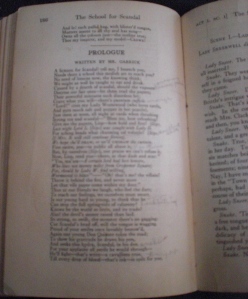 The student who provided the marginalia on this page sought to understand the vocabulary that Sheridan used. Enough was written after the line, “Crave what you will–there’s quantum sufficit”. “Sal volatile” was underlined and smelling salts was written by the student, while “hydra” led to snake, and positive was jotted in the margin after a line containing “poz”.
The student who provided the marginalia on this page sought to understand the vocabulary that Sheridan used. Enough was written after the line, “Crave what you will–there’s quantum sufficit”. “Sal volatile” was underlined and smelling salts was written by the student, while “hydra” led to snake, and positive was jotted in the margin after a line containing “poz”.
When viewing another page, the same theme is found, with slight variations. The student used the margins to define words in the text, and also bracketed certain paragraphs as well, always in pencil. “Insipid” led to weak, and “raillery” was defined as gay ridicule. Of course, the connotation of the word gay was quite different when the student had written these notes. Raillery is defined today as good-humored teasing, so I’m not sure the students’ inclusion of ridicule fits best.
Finally, I discovered that pencil was not the only marking implement found inside this book. Whether it was coffee, wine, blood, or something else entirely, there are about eight to ten pages that have some unfortunate staining. Just as I’m writing this today with the aid of a cup of coffee (at a safe distance from the book itself), a student from the past had done something similar, without as much luck.
I got carried away in the library looking for books that would meet the criteria for this project. I must have spent at lease two hours total searching high and low. I want to share some of my smaller discoveries in addition to the one that I think is the most substantial.
The first marking of interest came from a book called The Life of Laurence Sterne by Percy Fitzgerald. (1896, Downey & Co. 21 York St., Covent Garden, London) This book has a script (probably male?) name, “Letteme” in the first few pages under a black and white photograph of a man. It looks authentic (pen type and writing style, dark/light, etc.) but I’m not positive that it’s written and not copied or printed.
The second book I looked at was Shakespeare’s Tragedy of Othello, The Moor Of Venice, edited, with notes, by William J. Rolfe. (1886, New York” Harper & Brothers, Publishers, Franklin Square.) This book has a name and date “Nellie F. Bates March 1887” in the light, more frilly andornate feminine looking penmanship. This book also included many markings within the body text pages but it seems to be much more modern and probably done by students using the books for projects etc. I’m including a picture of these markings anyway because I still think they’re interesting.
It is my inference that both of these old signatures are just the names of the people who owned the books wanting to mark them as their property.
The third and most interesting marginalia I found went beyond just a name within the first few pages. This book, by Mark Twain, entitled Happy Tales (1892, New York: Charles L. Webster & Co.) has a note indicating that the book was a gift from one person to another as they were leaving. The note reads, (though I’m not sure I’m transcribing the names 100 percent accurately) “For Ada B. Richardiore from her friend Annie M. Amred. ‘Bon Voyage’ — April 30. 1892.” What I’m putting together is that this was a woman giving this book of short stories to her leaving friend, that they may not see each other for a long time or even ever again, and finally that she wants her friend to have “Happy Tales” of her own.
*Here is the link to my entry on Book Traces!
I was rather upset to not find anything for the Book Traces website. I find the overall idea and assignment super fascinating and hoped to find something interesting or at least authentic in my search but I unfortunately had no luck. I spent over three hours searching the stacks for a book with some sort of writing in it. I looked all through poetry, literature, letters, history, religion and more. I really felt confident that poetry or literature would have something and spent most of my time in the PR and PS section. Overall, I was really disappointed.
I found a few books with pencils markings and writing in them but I had no way of telling when that was done for example, The Life of Sterne by Percy Fitzgerald and Sesame and Lilies by John Ruskin. One book The English Poets by T.H. Ward got me especially excited because it appeared to be marked all over with notes about the poems and inferred meanings behind certain symbols but on further examination I realized the writing was too current as on one of the final pages it was dated for a lesson plan. For a few others the writing was clearly done in ballpoint pen. I also found books that had what I thought to be markings but turned out to be printed that way like Life and Letters by Robert Browning which had what I thought was a signature but sadly wasn’t. One book tricked me because I thought it contained a handwritten letter from the late 1800s but the letter was bound into the book and was apart of the story. The closest I came to finding any sort of authentic ancient article was a receipt in a book from 2004. Everything else seemed to be a dead end.
I do not really understand how I did not find anything as I looked through a variety of books and focused on the two sections that seemed to have the most luck for other people. A section like poetry or literature would seem to have a lot of writing in it as people try to deceiver what the author is trying to say or as they make comparisons to their own life. There were also a few books that were about other languages such as Irish and Scottish books and I hoped that they would have markings about the translations or something along those lines but again nothing. In all, I enjoyed looking through the well over 50 books and wish I had found something but the appearance of the books themselves with interesting some had marble like patterns on the seems and one book had pink pages but I never found what I set out to find.
While I was playing around with the Google Ngrams viewer this weekend, I came across an interesting discovery. If you search the terms “men, women” a very interesting graph displays itself. Women are mentioned severely less than men are in Google’s databases, that is until you hit around the year 1983. From that year on, the balance (or lack thereof) begins to shift very dramatically. Not only is the word “women” mentioned more after this year, but “men” is mentioned less! To me, this is astonishing, because if you take a look at, say, the year 1810, women are mentioned a mere 0.01 while men are almost mentioned 0.1%! This may not seem like that big of a number, but considering the amount of words that Google is referencing here, that is a pretty hefty number! Especially compared to the little amount that Women is mentioned! To me, this represents the constant war of the sexes that is going on in our world, and really makes me glad that is has shifted. Even though there is a lot of work to be done in the way of complete equality, I think that this is quite an amazing thing to have changed so radically from both directions, and have these two lines meet in the middle.
-Austin Carpentieri
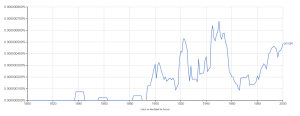
P. S.- While futzing around with the viewer, I typed in the word “google” and came across some…puzzling results. I don’t know if this is a glitch in the system or what, but I have no clue who was using the word “google” in the 1840s, or why 1950 is the peak for this word. I have no clue it really is puzzling.
In my travels into the library, finding a book that had writing in it was very difficult. This may be something to be happy about, that people are respectful of books, but in my case of research, it was not preferable. Upon finding the novel English Literature From the Beginning to the Norman Conquest on the highest shelf in the stacks of Sojourner Truth Library, I had confidence that this was the book I was looking for. And I was right to feel such a way, for when I opened the book I stumbled upon many mysterious inscriptions
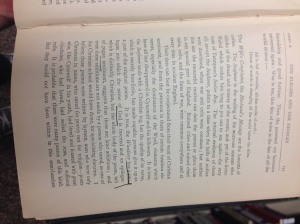
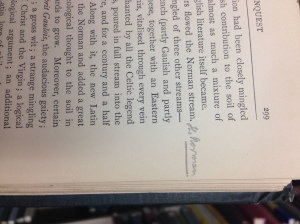
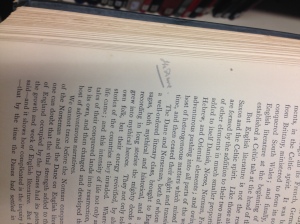 In the first picture, the word God, amoung two others, is underlined. It is difficult to say what the intention was for underlining this word, but it is interesting to know that there is endless possibilities for the underlining of a word such as God. The word God has different meanings for every individual on Earth, therefore this word is especially mysterious in its placement. The two words in the other two pictures that are almost illegibly scribbled onto the pages are almost equally as mysterious as they are perceived to me to say “the same” and “the norman”.
In the first picture, the word God, amoung two others, is underlined. It is difficult to say what the intention was for underlining this word, but it is interesting to know that there is endless possibilities for the underlining of a word such as God. The word God has different meanings for every individual on Earth, therefore this word is especially mysterious in its placement. The two words in the other two pictures that are almost illegibly scribbled onto the pages are almost equally as mysterious as they are perceived to me to say “the same” and “the norman”.
The book itself was published in the United States in 1908, first edition in 1898. The author Stopford A. Brooke was born in 1832, and died in 1916 and was an Irish churchman, royal chaplain and writer. Since the novel itself is a collection of english literature and criticisms by the author himself, it is again difficult to connect the inscribed words to a reasoning for the existence. The greatest attribute of literature is that the author may intend something for the reader to grasp inside the writings of a book, but the reader himself will always find his own meaning of the words. This in itself is why these inscriptions are so interesting, and so very, very mysterious.